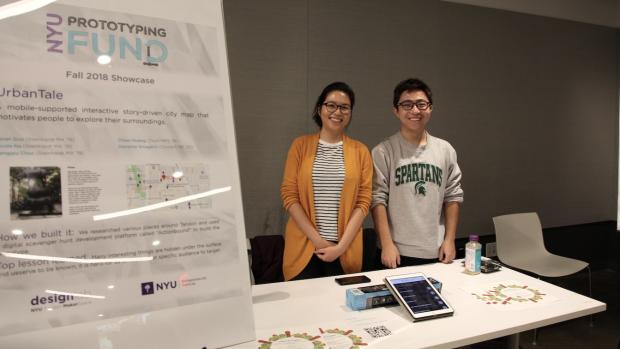Tandon Inventors Present Human-Centered Designs at Fall Prototyping Fund Showcase

“We're developing assistive tech for our client, who is hearing impaired,” explained Krizia Fernando, inventor of the Visual Doorbell, on display at the NYU Prototyping Fund Showcase for the Fall 2018 semester. “She told us she asks people to text her if they’re coming over, hours in advance, because she’s never prepared when people stop by.”
Knowing their client needed a notification system that was not based on sound, Fernando’s team, which includes Tandon and Steinhardt grad students Steven Medina and Arwa Alrajeh, respectively, developed a device that uses simple, visual communication. Their current prototype communicates wirelessly to the light-up main housing of the Visual Doorbell whenever pressure is applied to a nearby button. Demoing the product, Medina tapped the button across the table from the “doorbell,” causing the device to emit several flashes of yellow light. The button and flashing light are not attached so that the device can be moved to different locations within their client’s home. That way, it’s nearby if visitors drop by unexpectedly. Medina and Fernando explained that their biggest challenge is finding a power source for the switch that sends the signal — it will need to plug into something, but also be on outside of the user’s home. They’ll work on that in the next iteration of the project.
And they will have the opportunity to improve their creation: all participants in the first round of the Prototyping Fund can apply to go on with prototyping phase 2.0. In this stage, participants receive $2,000 to iterate on and improve their design. They also receive support from the NYU Leslie E-Lab, if their intention is to build a startup based around their product, or if they’re working with an established company to polish and market their invention.
Anne-Laure Fayard, a professor at NYU Tandon, co-organized the Prototyping Fund with Sarah Maibach from the NYU Entrepreneurial Institute. She pointed out that a great example of success is the We Are the New Farmers team. We Are the New Farmers, a self-contained urban farming system, got its start with the Prototyping Fund and last year won the NYU Green Grant, a $20,000 award that will allow the WATNF innovators to attend outside agricultural class and events and fund individual projects.
Designing for the common good is not a concept unique to We Are the New Farmers. Projects showcased at this semester’s event had a particular focus: human-centered design.
In the last few years, we've seen an increasing number of ideas focusing on social issues. Students are designing for people with disabilities, or for medicine, or the environment. It’s really great to see." — Professor Anne-Laure Fayard
Digistrips, a urinary tract infection (UTI) diagnosis tool, got its start with this semester’s Prototyping Fund, and is now awaiting FDA approval to be used for testing on patients. An invention of Denize Vurmaz (Tandon ‘21), Sayli Modak (Tandon ‘15), and Shruti Warhadpande, Digistrips consist of 3D-printed cups lined with adhesive paper strips that change color based on the sulfide content of the patient’s urine. The amount of sulfide tells the user whether or not they have an infection, and should seek treatment. Vurmaz explained that the easy-to-use cups would allow patients to get diagnosed quickly and receive medicine to treat their UTIs in the same day.
The Auto-Adapter, another Prototyping Fund project with a medical focus, was designed by Renee-Tyler Morales (Tandon ‘18), Kevin Guan (Tandon ‘18), and Grace Park (Tandon BS/MS ‘19). It’s an automated cell culture platform that recreates the conditions that stimulate disease. For example, the team explained, that you can simulate disease. You could monitor what's going on in the cells in 24 hours that a person has a chaotic, medical emergency like a stroke — you could analyze how cells behave before, during, and after a stroke and actually observe the genesis of new blood vessels.
Mental health was considered by this semester’s Prototyping Fund participants as well. Tongda Xu (Tandon MS ‘20) and Shuyi Chang (Tisch MFA ‘20) created a wearable device that soothes users by displaying calming virtual reality (VR) scenes on an Oculus headset attached to a larger headpiece that monitors the user’s emotions. The device registers which visuals the user responds to with positive emotions and seeks out similar VR scenes for future use.
Nearby, Octavia Larentis (Tandon MS ‘19) and Monica Mendoza (Tandon MS ‘19 ) displayed their prototype for Beespect, a beehive model that allows commercial beekeepers to monitor and manage hive health. An arduino-enabled sensor network on the lid of the hive measures humidity, temperature, and food supply. Larentis and Mendoza have not tested their prototype on live bees yet, but they have secured two beehives on the Lower East Side, and will use them for testing, one with sensor-enabled lid and one without any electronic hardware, as a control group.
All the Fall 2018 Prototyping Fund participants will be invited to participate in the Fund’s 2.0 session next semester. But new participants will also have a chance to innovate: The $500 prototyping fund will reopen at the beginning of the spring semester for new participants who want to bring their yet-undeveloped inventions to life.
Annie Brinich
NYU Tandon School of Engineering
Master of Science in Integrated Digital Media, Class of 2019




